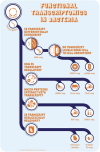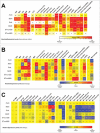Functional Transcriptomics for Bacterial Gene Detectives
- PMID: 30215343
- PMCID: PMC11633634
- DOI: 10.1128/microbiolspec.RWR-0033-2018
Functional Transcriptomics for Bacterial Gene Detectives
Abstract
Developments in transcriptomic technology and the availability of whole-genome-level expression profiles for many bacterial model organisms have accelerated the assignment of gene function. However, the deluge of transcriptomic data is making the analysis of gene expression a challenging task for biologists. Online resources for global bacterial gene expression analysis are not available for the majority of published data sets, impeding access and hindering data exploration. Here, we show the value of preexisting transcriptomic data sets for hypothesis generation. We describe the use of accessible online resources, such as SalComMac and SalComRegulon, to visualize and analyze expression profiles of coding genes and small RNAs. This approach arms a new generation of "gene detectives" with powerful new tools for understanding the transcriptional networks of Salmonella, a bacterium that has become an important model organism for the study of gene regulation. To demonstrate the value of integrating different online platforms, and to show the simplicity of the approach, we used well-characterized small RNAs that respond to envelope stress, oxidative stress, osmotic stress, or iron limitation as examples. We hope to provide impetus for the development of more online resources to allow the scientific community to work intuitively with transcriptomic data.
Figures





Similar articles
-
SFGD: a comprehensive platform for mining functional information from soybean transcriptome data and its use in identifying acyl-lipid metabolism pathways.BMC Genomics. 2014 Apr 8;15:271. doi: 10.1186/1471-2164-15-271. BMC Genomics. 2014. PMID: 24712981 Free PMC article.
-
Salmonella transcriptomics: relating regulons, stimulons and regulatory networks to the process of infection.Curr Opin Microbiol. 2006 Feb;9(1):109-16. doi: 10.1016/j.mib.2005.12.010. Epub 2006 Jan 18. Curr Opin Microbiol. 2006. PMID: 16413221 Review.
-
Integrative analysis of large scale expression profiles reveals core transcriptional response and coordination between multiple cellular processes in a cyanobacterium.BMC Syst Biol. 2010 Aug 2;4:105. doi: 10.1186/1752-0509-4-105. BMC Syst Biol. 2010. PMID: 20678200 Free PMC article.
-
Whole genome transcriptomics reveals global effects including up-regulation of Francisella pathogenicity island gene expression during active stringent response in the highly virulent Francisella tularensis subsp. tularensis SCHU S4.Microbiology (Reading). 2017 Nov;163(11):1664-1679. doi: 10.1099/mic.0.000550. Epub 2017 Oct 16. Microbiology (Reading). 2017. PMID: 29034854 Free PMC article.
-
A primer for generating and using transcriptome data and gene sets.Development. 2020 Dec 23;147(24):dev193854. doi: 10.1242/dev.193854. Development. 2020. PMID: 33361089 Free PMC article. Review.
Cited by
-
Micromix: web infrastructure for visualizing and remixing microbial 'omics data.Gigascience. 2025 Jan 6;14:giae120. doi: 10.1093/gigascience/giae120. Gigascience. 2025. PMID: 39898450 Free PMC article.
-
Intracellular niche-specific profiling reveals transcriptional adaptations required for the cytosolic lifestyle of Salmonella enterica.PLoS Pathog. 2021 Aug 30;17(8):e1009280. doi: 10.1371/journal.ppat.1009280. eCollection 2021 Aug. PLoS Pathog. 2021. PMID: 34460873 Free PMC article.
-
Complex Responses to Hydrogen Peroxide and Hypochlorous Acid by the Probiotic Bacterium Lactobacillus reuteri.mSystems. 2019 Sep 3;4(5):e00453-19. doi: 10.1128/mSystems.00453-19. mSystems. 2019. PMID: 31481604 Free PMC article.
-
Infection-based chemical screens uncover host-pathogen interactions.Curr Opin Microbiol. 2020 Apr;54:43-50. doi: 10.1016/j.mib.2019.12.003. Epub 2020 Feb 7. Curr Opin Microbiol. 2020. PMID: 32036306 Free PMC article. Review.
-
Adding function to the genome of African Salmonella Typhimurium ST313 strain D23580.PLoS Biol. 2019 Jan 15;17(1):e3000059. doi: 10.1371/journal.pbio.3000059. eCollection 2019 Jan. PLoS Biol. 2019. PMID: 30645593 Free PMC article.
References
Publication types
MeSH terms
Substances
Grants and funding
LinkOut - more resources
Full Text Sources
Other Literature Sources

